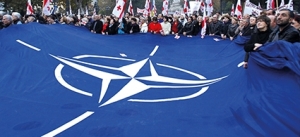On Georgia Joining NATO (without Sparking a War with Russia)
Op-Ed
As NATO prepares for its Summit in July, the issue of enlarging the Alliance is sure to come up, and in particular, the case of Georgia whose territory is par. This year marks the 10th anniversary of the Bucharest Summit, at which NATO promised eventual membership to the South Caucasus country.
With each succeeding summit, NATO has reaffirmed its commitment to Georgia and it regularly introduces measures to improve Georgia’s interoperability with the Alliance; in December 2016, Secretary General Jens Stoltenberg declared that Georgia “has all the practical tools to become a member of NATO.” Even so, the country’s journey toward NATO membership has been long, at times frustrating, and is apparently far from over.
US and European policymakers say one of the biggest concerns about admitting Georgia into the alliance is Russia’s occupation of the country’s Tskhinvali (South Ossetia) and Abkhazia regions. If Georgia joined NATO, the theory goes, the treaty’s Article 5 mutual security guarantee would immediately require members to go to war against Russia. No matter what is said publicly, many policymakers believe that as long as these regions are under Russian occupation, Georgia can never join NATO.
Indeed, Moscow is of the same opinion, and views occupation as a de facto veto. However, there is a way around this problem.
All of Georgia’s internationally recognized territory, which includes the Tskhinvali region and Abkhazia, could be invited to join NATO. However, NATO could amend Article 6 of the 1949 treaty (which defines which territories fall under the Article 5 protection) to temporarily exclude only the Russian-occupied region from NATO’s Article 5 protection. So in summary, all of Georgia would join NATO, but only the regions of Georgia NOT under Russian occupation.
It is important to point out that this would only be a temporary measure, intended to last only until Georgia’s full, internationally recognized territory can be re-established by peaceful means.
There is a precedent for amending Article 6. It was done in 1951 as part of the accession protocol for Turkey and Greece when they joined NATO. Twelve years later, the North Atlantic Council noted the original inclusion of the Algerian Departments of France in Article 6 was no longer applicable due to Algeria’s independence.
In addition, there are countless examples of NATO members not having all of their territory under the protection of Article 5. Think the US and Guam or the UK and the Falkland Islands.
Further, allowing Georgia to join NATO with an amended Article 6 is consistent with the country’s pledge to abstain from retaking the occupied regions by force. This is why this proposal could not work for Ukraine, for example, because Kyiv has made no such pledge regarding the Donbas and Crimea.
Admittedly, this proposal is not without its challenges. For it to work, real political leadership is needed in Washington DC and Tbilisi. The US will have to convince Europeans that it is successfully heading off an automatic war with Russia. The Georgian government will have to explain to its people that this does not mean abandoning the two occupied regions and that it is in line with the non-use of force pledge.
Right now, Russia knows that all it has to do to prevent a country from ever joining NATO is to invade and then partially occupy it. Temporarily amending Article 6 would deny Moscow this veto, starting with Georgia. The only question is whether leaders on both sides of the Atlantic have the required creativity and political will for it.
We will have to wait for the Summit and see what it will bring for Georgia.
By Shawn Wayne












